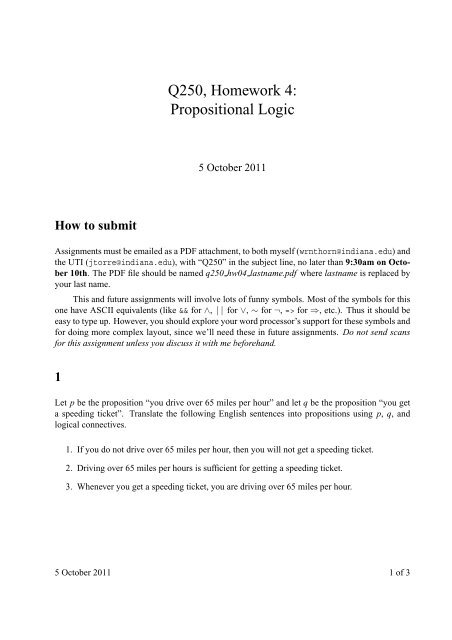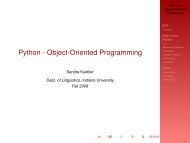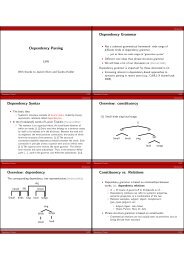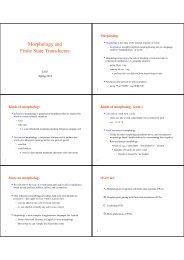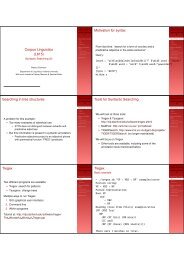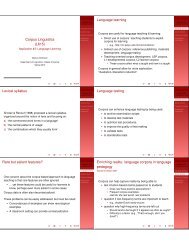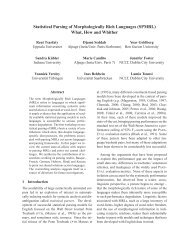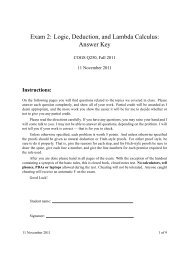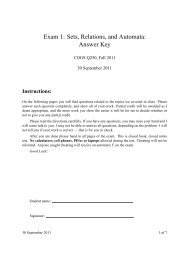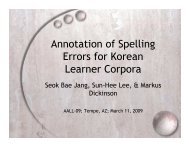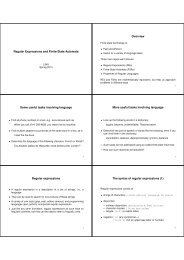Q250, Homework 4: Propositional Logic
Q250, Homework 4: Propositional Logic
Q250, Homework 4: Propositional Logic
Create successful ePaper yourself
Turn your PDF publications into a flip-book with our unique Google optimized e-Paper software.
<strong>Q250</strong>, <strong>Homework</strong> 4:<br />
<strong>Propositional</strong> <strong>Logic</strong><br />
5 October 2011<br />
How to submit<br />
Assignments must be emailed as a PDF attachment, to both myself (wrnthorn@indiana.edu) and<br />
the UTI (jtorre@indiana.edu), with “<strong>Q250</strong>” in the subject line, no later than 9:30am on October<br />
10th. The PDF file should be named q250 hw04 lastname.pdf where lastname is replaced by<br />
your last name.<br />
This and future assignments will involve lots of funny symbols. Most of the symbols for this<br />
one have ASCII equivalents (like && for ∧, || for ∨, ∼ for ¬, => for ⇒, etc.). Thus it should be<br />
easy to type up. However, you should explore your word processor’s support for these symbols and<br />
for doing more complex layout, since we’ll need these in future assignments. Do not send scans<br />
for this assignment unless you discuss it with me beforehand.<br />
1<br />
Let p be the proposition “you drive over 65 miles per hour” and let q be the proposition “you get<br />
a speeding ticket”. Translate the following English sentences into propositions using p, q, and<br />
logical connectives.<br />
1. If you do not drive over 65 miles per hour, then you will not get a speeding ticket.<br />
2. Driving over 65 miles per hours is sufficient for getting a speeding ticket.<br />
3. Whenever you get a speeding ticket, you are driving over 65 miles per hour.<br />
5 October 2011 1 of 3
<strong>Q250</strong>, <strong>Homework</strong> 4<br />
2<br />
Patricia, Quincy, and Rachel are in class together. Translate the following propositional statements<br />
about them into the most natural equivalent English statements, where: p is the proposition “Patricia<br />
will pass”, q is the proposition “Quincy will pass”, and r is the proposition “Rachel will<br />
pass”.<br />
1. ¬p∧¬q∧¬r<br />
2. p∧q∧r<br />
3. (p∧¬q∧¬r)∨(¬p∧q∧¬r)∨(¬p∧¬q∧r)<br />
4. (q∨r)⇒¬p<br />
3<br />
State the converse and contrapositive for each of the following implications.<br />
1. If it snows today, I will ski tomorrow.<br />
2. I come to class whenever there is going to be a quiz.<br />
4<br />
Construct truth tables for each of the following propositions. Keep in mind that it may be useful<br />
to record the truth values of intermediate expressions as well (e.g., when constructing a truth table<br />
for (q∨r)⇒¬ j, it may be helpful to first write down the truth values for (q∨r)).<br />
1. (p∨q)⇒(p∧q)<br />
2. (p⇒q)⇔(¬q⇒¬p)<br />
3. (p⊻q)∧(p⊻¬q)<br />
4. (¬p⇔¬q)⇔(p⇔q)<br />
5. (p⇔q)∨(¬q∧¬r)<br />
6. (p⊻q)∨(q⇔r)<br />
5 October 2011 2 of 3
<strong>Q250</strong>, <strong>Homework</strong> 4<br />
5<br />
Show that(p⇒q)⇒r and p⇒(q⇒r) are not equivalent.<br />
6<br />
For each of the following propositions, indicate whether it is a tautology, contradiction, or contingency.<br />
If it is a contingency, provide two truth value assignments which demonstrate that this is<br />
the case (i.e., provide one set of assignments that makes the proposition true and one that makes it<br />
false).<br />
1. ¬(p∨q)⇔(¬p∧¬q)<br />
2. (p⇔q)∨(¬q∧¬p)<br />
3. (p⇔q)∧(q⇒¬p)⇒(p∧r)<br />
4. (p∧q)∧¬(p∨q)<br />
5. ((p⇒q)∧(p⇒¬q))⇔¬p<br />
7<br />
Consider the following problem: Jones, Smith, and Clark hold the jobs of doctor, lawyer, and<br />
veterinarian (not necessarily in that order). Jones owes the doctor $10. The veterinarian’s spouse<br />
prohibits borrowing money. Smith is not married. Which person holds which job?<br />
Use propositional logic to solve this problem. Use propositional symbols to represent the<br />
nine different possible person/job assignments (e.g., JonesIsTheDoctor or just JD). Represent the<br />
six possible solutions to this problem as logical expressions (e.g., one possible solution is JD∧<br />
SL∧CV). Clues should be represented as additional logical expressions (e.g., from “Smith is not<br />
married” and “the veterinarian’s spouse” you know that Smith cannot be the veterinarian, which<br />
you can represent as¬SV). Show how the clues can be used to eliminate all but one of the possible<br />
solutions.<br />
5 October 2011 3 of 3


